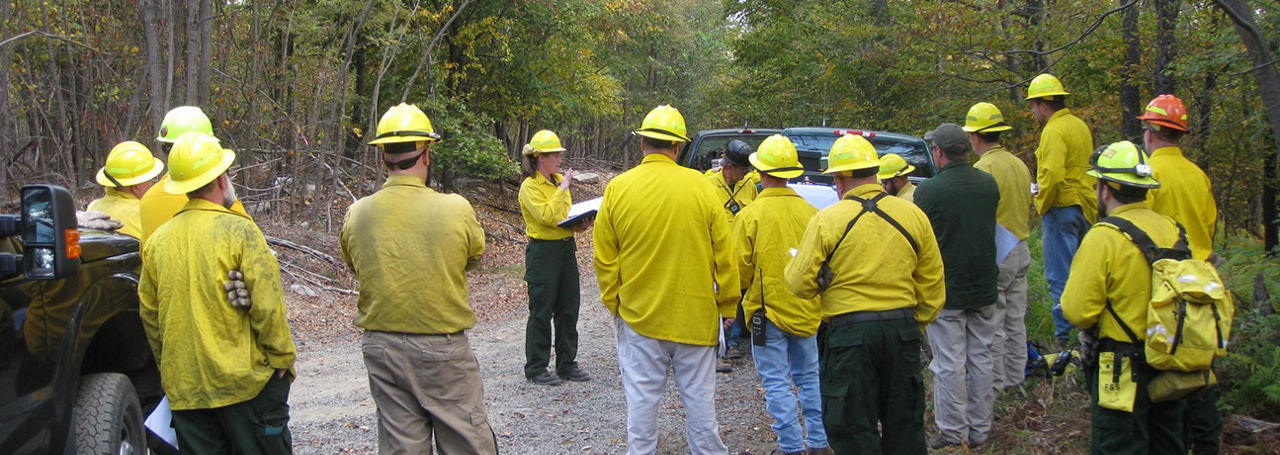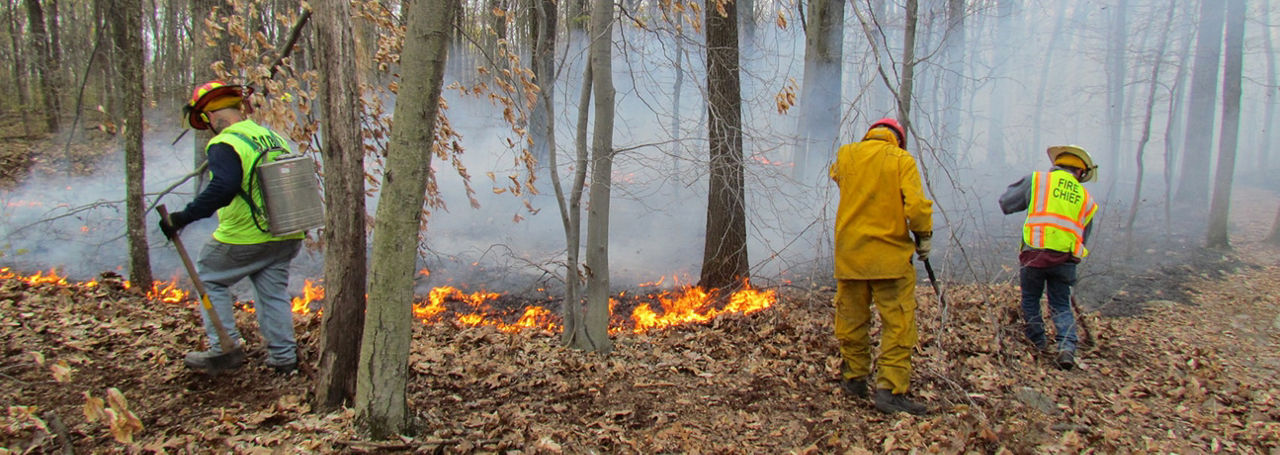
Burn Bans
Learn More
Become a Forest Fire Warden
Learn More
Volunteer Fire Department Resources
Learn More
Wildfire Danger Ratings
Learn MoreIn Pennsylvania, 99 percent of all wildfires are caused by people.
Certain conditions are necessary for a wildfire to occur:
- An available fuel source, such as dried grass or leaves
- Dry conditions, including low relative humidity
- An ignition source -- some way for the fire to start
The first two factors occur most frequently in Pennsylvania during spring and autumn.
As the spring sun climbs higher in the sky, days become longer and warmer.
The trees are bare during this time, allowing sunlight to reach the forest floor, warming the ground, and drying surface fuels.
Coupled with strong and dry spring winds, this leads to a tremendous amount of combustible fuels.
During autumn, leaves turn color and begin to fall, accumulating in a deep, fluffy layer that creates a fire hazard.
The third factor, an ignition source, also frequently occurs during these periods.
Debris Burning is the Leading Cause of Pennsylvania Wildfires
One of the major causes of forest fires in Pennsylvania is debris burning.
A careless person burning trash or yard waste can be responsible for causing wildfires that burn thousands of acres of valuable Pennsylvania forests.
These fires most frequently start in someone’s backyard and travel through dead grass and leaves into bordering woodlands.
Of course, wildfires can occur during any month and any time of day, destroying woodlands and wildlife habitat, and threatening human lives, homes, and buildings.
While media outlets often give more coverage to devastating western wildfires, most wildfires occur east of the Mississippi River.
Reducing the Risks of Wildfire
Census figures for the first decades of the 21st century show more people in the Northeastern U.S. moving from suburban to rural areas to make their home near or within the forest.
Firefighters call the area where homes and development meet and intermingle with undeveloped forests the “wildland-urban interface.”
More than half of all wildfire ignitions in Pennsylvania occur within the wildland-urban interface.
People moving into the wildland urban interface often make choices that increase the potential for their homes to be destroyed by wildfire.
With more people there is increased risk of fires caused by:
- Debris burning
- Equipment use
- Power lines
- Campfires
Wildfire Prevention
Debris burning is the most common cause of wildfires in Pennsylvania.
Check with your township for burn bans and local ordinances on debris burning.
Wildfire prevention is a message brought to people across the country by the well-known figure, Smokey Bear.
Detailed information about wildfire prevention as well as materials for kids and educators is on the Smokey Bear website.
Wildfire Mitigation
In the wildland-urban interface, it is especially important to properly prepare your residence in the event of a wildfire.
To reduce your risk of a fire igniting within the Home Ignition Zone (the area surrounding your residence), it is recommended that you:
- Keep the area at 0-5 feet (Immediate Zone) clear of all combustible materials
- Create breaks within the landscape at 5-30 feet (Intermediate Zone)
- Include interruptions within the forested landscape at 30-100 feet (Extended Zone)
Please refer to the National Fire Protection Association website for additional information.
Battling Wildfires in Pennsylvania FAQ
The Department of Conservation and Natural Resources (DCNR) Bureau of Forestry is responsible for protecting the Commonwealth’s 17 million acres of public and private wildlands from damage by wildfire.
When a wildfire breaks out, DCNR is the lead in coordinating efforts with other state agencies, local fire departments, and federal agencies like the U.S. Forest Service. The department may send firefighters, specialized equipment, and other resources to support the response. DCNR staff help ensure that the right resources are in place to fight the fire and prevent it from spreading further.
There are systems, strategies, and terms that are used when fighting wildfires.
An Incident Management Team is a group of trained professionals who work together to manage and control a wildfire. They organize and coordinate all efforts to fight the fire, ensure safety, and protect people, property, and the environment. They make key decisions and lead firefighting teams. The Incident Commander is the person in charge of the whole wildfire response and the leader of the entire team.
The leader uses a system to organize all the teams and resources during a wildfire or emergency. It helps make sure everyone knows their role and that things run smoothly.
Control means that firefighters have stopped the fire from spreading further. They have managed to surround and contain the fire, and they’re working to prevent the fire from getting any larger.
A fire line is a boundary that firefighters create by clearing away trees, brush, and other flammable materials. It helps stop the fire from spreading because there’s nothing left for the fire to burn in that area.
Containment means that the firefighters have surrounded the wildfire and stopped it from moving beyond a certain point. The fire is not completely out, but it's controlled and can’t spread any further.
A hot spot is a small area in the 'black' or burned area where the fire is still burning strongly, even after it seems like the fire is under control. These spots can reignite the fire, so firefighters need to find and put them out quickly.
Mop-up is the final stage of firefighting. It involves making sure that the fire closest to the perimeter is completely out by putting out any remaining flames or hot spots. It’s like cleaning up after the fire is mostly controlled.
Backburning is a technique used by firefighters to stop a wildfire. They start a controlled fire in front of the main fire, burning all the fuel before the wildfire can reach it. This helps stop the wildfire from spreading.
Air attack refers to using aircraft like helicopters or airplanes to help suppress the fire. They might drop water or fire retardant from above to help the ground crews understand where the fire is spreading. Air resources are most effective on initial attack.
A fire weather forecast is a special weather report that tells firefighters about conditions that can affect the fire. This includes temperature, humidity, wind speed, and other weather factors that can make a fire spread faster or slower.
Evacuation means that people living in or near the fire zone are asked to leave the area to stay safe. This is done when the fire is threatening homes, businesses, or communities. Evacuation orders are given by local authorities.

